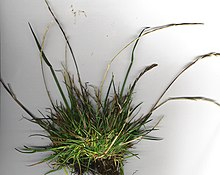Ryegrass: Difference between revisions
m Reverting possible vandalism by 194.66.191.22 to version by Atubeileh. False positive? Report it. Thanks, ClueBot. (540828) (Bot) |
short and compact |
||
| Line 28: | Line 28: | ||
*''[[Lolium rigidum]]'' Gaudin - Stiff Darnel, Wimmera Ryegrass |
*''[[Lolium rigidum]]'' Gaudin - Stiff Darnel, Wimmera Ryegrass |
||
*''[[Lolium temulentum]]'' L. - Darnel, Poison Darnel |
*''[[Lolium temulentum]]'' L. - Darnel, Poison Darnel |
||
chirs is s gaylord motherfucker and loves crack |
|||
==Cultivation and uses== |
==Cultivation and uses== |
||
Ryegrasses contain some species which are important grasses for both [[lawn]]s, and as [[pasture]] and for grazing and [[hay]] for [[livestock]], being a highly nutritious stock feed. Ryegrasses are also used in [[soil]] [[erosion]] control programs. It is the principal grazing grass in [[New Zealand]] where some 10 million kilograms of certified seed are produced every year. There is a large range of [[cultivar]]s. The primary species found worldwide and used for both lawns and as a forage crop is [[perennial ryegrass]] (''Lolium perenne''). Like many cool-season grasses, it is often infected by a clandestine, fungal endophyte which lives symbiotically within its leaves. |
Ryegrasses contain some species which are important grasses for both [[lawn]]s, and as [[pasture]] and for grazing and [[hay]] for [[livestock]], being a highly nutritious stock feed. Ryegrasses are also used in [[soil]] [[erosion]] control programs. It is the principal grazing grass in [[New Zealand]] where some 10 million kilograms of certified seed are produced every year. There is a large range of [[cultivar]]s. The primary species found worldwide and used for both lawns and as a forage crop is [[perennial ryegrass]] (''Lolium perenne''). Like many cool-season grasses, it is often infected by a clandestine, fungal endophyte which lives symbiotically within its leaves. |
||
Revision as of 14:42, 2 February 2010
| Ryegrass | |
|---|---|

| |
| Perennial Ryegrass (Lolium perenne) | |
| Scientific classification | |
| Kingdom: | |
| (unranked): | |
| (unranked): | |
| Order: | |
| Family: | |
| Genus: | Lolium |
| Species | |
|
See text | |
This article needs additional citations for verification. (June 2008) |
Ryegrass (Lolium) is a genus of nine species of tufted grasses, family Poaceae. Also called tares (even though there is no firm evidence that this is the same as the plant given that name in English language translations of the Bible - vetches are another candidate), these plants are native to Europe, Asia and northern Africa, but are widely cultivated and naturalized elsewhere. Ryegrasses are naturally diploid, with 2n = 14, and are closely related to the fescues Festuca.
Ryegrass should not be confused with rye, which is a grain crop.
Species
The following are accepted as distinct species:
- Lolium canariense Steud. - Canary Islands Ryegrass
- Lolium edwardii H.Scholz, Stierst. & Gaisberg
- Lolium multiflorum Lam. - Italian Ryegrass
- Lolium perenne L. - Perennial Ryegrass
- Lolium persicum - Persian Ryegrass or Persian Darnel
- Lolium remotum Schrank
- Lolium rigidum Gaudin - Stiff Darnel, Wimmera Ryegrass
- Lolium temulentum L. - Darnel, Poison Darnel
chirs is s gaylord motherfucker and loves crack
Cultivation and uses
Ryegrasses contain some species which are important grasses for both lawns, and as pasture and for grazing and hay for livestock, being a highly nutritious stock feed. Ryegrasses are also used in soil erosion control programs. It is the principal grazing grass in New Zealand where some 10 million kilograms of certified seed are produced every year. There is a large range of cultivars. The primary species found worldwide and used for both lawns and as a forage crop is perennial ryegrass (Lolium perenne). Like many cool-season grasses, it is often infected by a clandestine, fungal endophyte which lives symbiotically within its leaves.
Some species, particularly L. temulentum, are weeds which can have a severe impact on the production of wheat and other crops. Ryegrass pollen is also one of the major causes of hay fever.
Many grass tennis courts are also made of rye grass in different compositions depending on the tournament.
Synonyms

- L. ambiguum = Lolium multiflorum
- L. annuum = Lolium temulentum
- L. arundinaceum = Festuca arundinacea
- L. berteronianum = Lolium temulentum
- L. brasilianum = Lolium perenne
- L. canadense = Lolium perenne
- L. crassiculme = Lolium rigidum
- L. cuneatum = Lolium temulentum
- L. dorei = Lolium persicum
- L. giganteum = Festuca gigantea
- L. gracile = Lolium temulentum
- L. lepturoides = Lolium rigidum subsp. lepturoides
- L. marschallii = Lolium perenne
- L. parabolicae = Lolium rigidum
- L. pratense = Festuca pratensis
- L. remotum = Lolium temulentum subsp. remotum
- L. romanum = Lolium multiflorum
- L. scabrum = Lolium multiflorum
- L. siculum = Lolium multiflorum
- L. subulatum = Lolium rigidum subsp. lepturoides
- L. teres = Lolium rigidum subsp. lepturoides
- L. trabutii = Lolium rigidum
